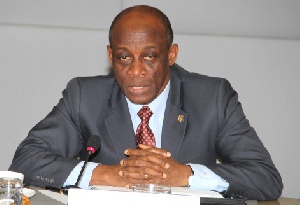 Finance Minister, Seth Terkper
Finance Minister, Seth Terkper
Analyzing the Ghanaian economy over the last 20 years (1996 till date), the years 2006, 2007,2008 and 2011 are arguably the periods that the economy performed very well, according to selected performance economic indicators compiled by the Institute of Statistical, Social and Economic Research (ISSER).
Comparing interest rates, Ghana’s economy recorded the lowest lending rate of 23.75 percent in its history in the year 2007while 24.25 percent,25.02 per cent and 26.95 percent were recorded in 2006, 2008 and 2011 respectively.
For the year 2015, the average lending rate stood at 32 per cent.
With regard to average inflation, the economy recorded inflation rates of 10.9, 10.7 and 8.58 in 2006, 2007 and 2011 respectively. In December 2015, the inflation rate was 17.7 per cent.
On end year 91-day Treasury bill, the yields for 2006, 2007 and 2011 were 10.6, 9.6 and 9.19 percent respectively. It recorded 24 percent yield in 2015.
For GDP, the economy grew at rates of 6.2, 6.5 and 14.4 (including oil) percent respectively for the periods 2006, 2007 and 2011 respectively. GDP for 2015 was 3.9 per cent.
For tax revenue to GDP, the periods 2006, 2007, 2008 and 2011 recorded 20.25, 22.87, 24.9 and 16.22 percent respectively. It registered tax revenue to GDP of ? percent in 2015.
According to the ISSER’s Policies and Options for Ghana’s Economic Development Report, despite hikes in oil prices in 2005 that affected economic activities around the world, the cedi was relatively stable against major international currencies. Its cumulative depreciation against the US dollar was 0.87 percent, resulting in the same inter-bank rate as in 2004 of 0.91 percent.
Ghana’s overall balance of payments position also turned from a deficit of US$10.4 million in 2004 to a surplus of US$213.8 million in 2005, primarily driven by increased payments on the capital account.
ISSER said the agricultural sector was the mainstay of the economy between 2003 and 2005, contributing more than 35 percent of total national output each year. The sector’s strong performance over the period was largely driven by improved yields and expansion of total output of the cocoa sub-sector.
The services sector also performed consistently as the second largest contributor to GDP over the period.
The industrial sector also contributed the least to GDP over the three-year period. The sector contributed 24.7 percent of national output in both 2004 and 2005.
Between 2001 and 2005, HIPC debt relief created substantial savings that helped poverty-related spending rise from 4.7 percent of GDP in 2001 to 8.5 percent in 2005, ISSER said.
It added that the savings also boosted the fiscal consolidation efforts of the government, thereby contributing strongly to a significant reduction in domestic debt servicing. Between 2002 and 2006 for instance, the burden of domestic debt servicing, as measured by the ratio of domestic debt relative to GDP, declined from a peak of 29.12 percent to about 15.2 percent.
This, however, happened in the face of a substantial increase in total debt stock of almost 25.2 percent over the 2005 stock, or from GH¢1,363.12 million in 2003 to GH¢1,706.12 million in 2006.
On future policy options, it stated that despite the significant improvements in the performance of the economy over the past two decades, a number of macroeconomic and structural challenges persist.
These include large fiscal and balance of payment deficits; over-reliance on the production of primary commodities without sufficient linkages to other sectors of the economy; predominance of rain-fed agriculture, low application of science, technology and innovation and rising growth rates not accompanied by improvements in human development indicators.
“Although the proportion of Ghana’s population defined as poor fell from 51.7 percent in 1991/1992 to 39.5 percent in 1998/1999 and further to 28.5 percent in 2005/2006, poverty still remains an important challenge.”
The ISSER report added that notwithstanding the significant improvements recorded in the Ghanaian economy, employment growth continues to lag behind, with high unemployment rates, especially among the youth.
The unemployment rate among the population in the 15-24 age groups was estimated at 25.6 percent in 2010, twice that of the 25-44 age groups and three times that of the 45-64 age groups.
ISSER describes it as a major socio-economic development concern which requires urgent policy response.
On the way forward, ISSER called for inclusive growth, saying “it is important to focus on the equitable participation of females, youth, and persons with disabilities in the economic growth process in order to reduce the growing inequalities associated with current growth and development efforts.”
According to ISSER, it is also prudent to pursue“an employment-centered economic growth strategy that will boost employment along with production and sustainable exploitation of Ghana’s natural resource endowment in agriculture, minerals and oil and gas, supported by strategic investments in human capital.”